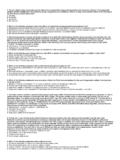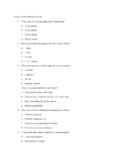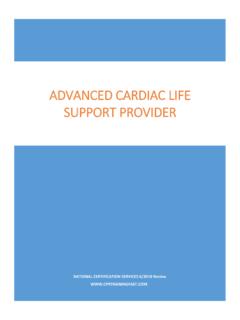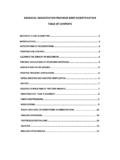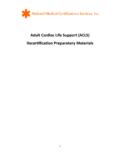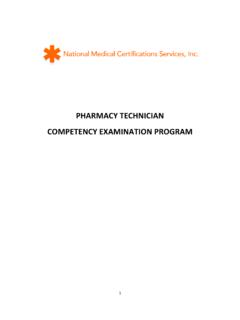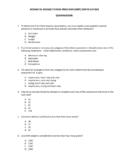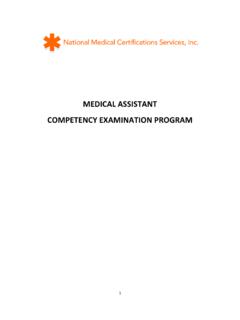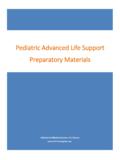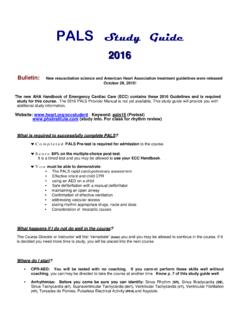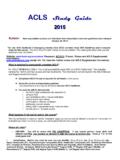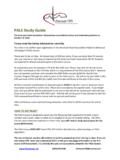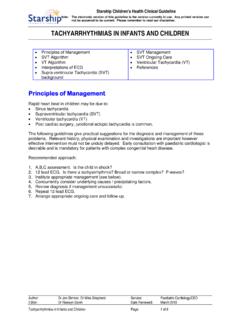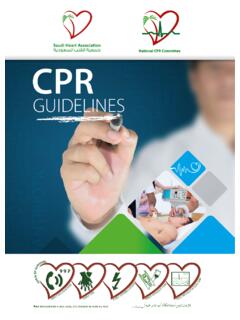Transcription of Pediatric Advanced Life Support (PALS) …
1 1 Pediatric Advanced life Support ( pals ) Recertification Preparatory Materials 2 Pediatric Advanced life Support ( pals ) RECERTIFICATION TABLE OF CONTENTS CYCLIC APPROACH 03 Pediatric ASSESSMENT FLOWCHART 04 MANAGEMENT OF RESPIRATORY EMERGENCIES FLOWCHART 05 MANAGEMENT OF SHOCK EMERGENCIES FLOWCHART 06 RECOGNITION OF SHOCK FLOWCHART 07 RECOGNITION OF RESPIRATORY PROBLEMS FLOWCHART 09 NORMAL VITAL SIGNS FOR Pediatric PATIENTS 10 ALGORITHMS FOR PEDIATRICS PULSELESS ARREST 11 BRADYCARDIA WITH A PULSE 13 TACHYCARDIA WITH ADEQUATE PERFUSION 14 TACHYCARDIA WITH PULSE AND POOR PERFUSION 15 AED TREATMENT ALGORITHM FOR PRE-HOSPITAL CRE OF CHILDREN >8 16 OVERVIEW OF RESUSCITATION IN THE DELIVERY ROOM 18 DRUGS USED IN Pediatric ADVANCEDLIFE Support 19 3 I. Cyclic Approach This is the cyclic approach used to assess and manage an ill or injured child.
2 It is repeated frequently during evaluation and management. Assess: Evaluation starts with the general assessment and continues with the primary assessment, the secondary assessment, and the tertiary assessment. If you recognize a life -threatening condition at any time in any assessment, begin interventions. Categorize: Attempt to categorize the child s condition by type and severity. Type Severity Respiratory Upper airway obstruction Lower airway obstruction Lung tissue disease Disordered control of breathing Respiratory distress Respiratory failure Circulatory Hypovolemic Shock Obstructive Shock Distributive/Septic Shock Cardiogenic Shock Compensated Shock Hypotensive Shock The child s condition may also be a combination of the two. As their condition deteriorates, one category may lead to others.
3 Decide: Now you need to decide on appropriate management based on your assessment and categorization of the child s condition. This is done based on your scope of practice. Act: Start treatment appropriate for the clinical condition. CategorizeDecideActAssess4 II. Pediatric Assessment Flowchart General Assessment: A appearance B work of breathing C circulation Primary Assessment: A airway B breathing C circulation D disability E - exposure Secondary Assessment: Also: S signs and symptoms A allergies M medications P past medical history L last meal / liquids consumed E events leading up to incident Focused physical examination Tertiary Assessment: Labs X-Rays Other tests as needed Categorize Illness by Type and Severity Type Severity Respiratory Upper airway obstruction Lower airway obstruction Lung tissue disease Disordered control of breathing Respiratory distress Respiratory failure Circulatory Hypovolemic Shock Obstructive Shock Distributive/Septic Shock Cardiogenic Shock Compensated Shock Hypotensive Shock Respiratory + Circulatory = Cardiopulmonary failure 5 III.
4 Management of Respiratory Emergencies Flowchart Airway positioning Oxygen Pulse oximetry ECG monitoring as needed BLS as needed Upper Airway Obstruction Specific Management for Selected Conditions Croup Anaphylaxis Aspiration Foreign Body Racemic epinephrine Corticosteroids IM epinephrine Albuterol Antihistamines Corticosteroids Allow position of comfort Specialty consultation Lower Airway Obstruction Specific Management for Selected Conditions Bronchiolitis Asthma Nasal suctioning Bronchodilator trial Albuterol and/or ipratropium Corticosteroids SQ epinephrine Magnesium sulfate Terbutaline Lung Tissue (Parenchymal) Disease Specific Management for Selected Conditions Pneumonia / Pheumonitis Infectious Chemical Aspiration Pulmonary Edema Cardiogenic or ARDS Albuterol Antibiotics as needed Consider noninvasive or invasive ventilator Support with PEEP Consider vasoactive Support Consider diuretic 6 Disordered Control of Breathing Specific Management for Selected Conditions Increased ICP Poisoning / Overdose Neuromuscular Disease Avoid hypoxemia Avoid hypercarbia Avoid hyperthermia Antidote (if available) Contact Poison Control Consider noninvasive or invasive ventilator Support This chart does not include all respiratory emergencies.
5 IV. Management of Shock Emergencies Flowchart Oxygen Pulse oximetry ECG monitor IV/IO access BLS as needed Bedside glucose Hypovolemic Shock Specific Management for Selected Conditions Nonhemorrhagic Hemorrhagic 20 mL/kg NS/LR bolus, repeat as needed Consider colloid after 3rd NS/RL bolus Control external bleeding 20 mL/kg NS/RL bolus repeat 2 or 3x as needed Transfuse PRBC s as indicated Distributive Shock Specific Management for Selected Conditions Septic Anaphylactic Neurogenic Management Algorithm Septic Shock IM epinephrine Antihistamines Corticosteroids Epinephrine infusion Albuterol 20 mL/kg NS/LR bolus, repeat PRN Vasopressor 7 Cardiogenic Shock Specific Management for Selected Conditions Brady / Tachyarrhythmia CHD, Myocarditis, Cardiomyopathy, Poisoning Management Algorithms: Bradycardia Tachycardia with poor perfusion 5-10 mL/kg NS/RL bolus, repeat PRN Vasoactive infusion Consider expert consultation Obstructive Shock Specific Management for Selected Conditions Ductal-Dependent Tension Pneumothorax Cardiac Tamponade Pulmonary Embolism Prostaglandin Expert Consultation Needle decompression Tube thoracostomy Peri-cardiocentesis 20 mL/kg NS/RL bolus 20 mL/kg NS/RL bolus, repeat PRN Consider thrombolytics, anticoagulants Expert consultation V.
6 Recognition of Shock Flowchart Clinical Signs: Hypovolemic Shock A - Airway-open and maintainable/not maintainable B - Respiratory rate-increased Effort-normal to increased Breath sounds-normal, maybe crackles C - Systolic blood pressure-Compensated to Hypotensive Pulse pressure-narrow Heart rate-increased Pulse quality-weak Skin-pale, cool Cap refill-delayed Urine output-decreased D - Level of consciousness-irritable early, lethargic late E - Variable 8 Clinical Signs: Distributive Shock A - Airway-open and maintainable/not maintainable B - Respiratory rate-increased Effort-normal to increased Breath sounds-normal, maybe crackles C - Systolic blood pressure-Compensated to Hypotensive Pulse pressure-wide Heart rate-increased Pulse quality-bounding or weak Skin-warm or cool Cap refill-variable Urine output-decreased D - Level of consciousness-irritable early, lethargic late E - Variable Clinical Signs.
7 Cardiogenic Shock A - Airway-open and maintainable/not maintainable B - Respiratory rate-increased Effort-labored Breath sounds-crackless, grunting C - Systolic blood pressure-Compensated to Hypotensive Pulse pressure-narrow Heart rate-increased Pulse quality-weak Skin-pale, cool Cap refill-delayed Urine output-decreased D - Level of consciousness-irritable early, lethargic late E - Variable Clinical Signs: Obstructive Shock A - Airway-open and maintainable/not maintainable B - Respiratory rate-increased Effort-labored Breath sounds-crackless, grunting C - Systolic blood pressure-Compensated to Hypotensive Pulse pressure-narrow Heart rate-increased Pulse quality-weak Skin-pale, cool Cap refill-delayed Urine output-decreased D - Level of consciousness-irritable early, lethargic late E - Variable 9 VI.
8 Recognition of Respiratory Problems Flowchart Clinical Signs: Upper Airway Obstruction A - Airway-open and maintainable/not maintainable B - Respiratory rate/effort-increased Breath sounds-stridor (typically inspiratory)-seal like cough- hoarseness Air movement-decreased C - Heart rate-increased Skin-pallor, cool skin (early) cyanosis (late) D - Level of consciousness-anxiety, agitation (early) lethargy, unresponsiveness (late) E - Variable Clinical Signs: Lower Airway Obstruction A - Airway-open and maintainable/not maintainable B - Respiratory rate/effort-increased Breath sounds-wheezing (typically expiratory) prolonged expiratory phase Air movement-decreased C - Heart rate-increased Skin-pallor, cool skin (early) cyanosis (late) D - Level of consciousness-anxiety, agitation (early) lethargy, unresponsiveness (late) E - Variable Clinical Signs.
9 Lung Tissue (Parenchymal) Disease A - Airway-open and maintainable/not maintainable B - Respiratory rate/effort-increased Breath sounds-grunting, crackles, decreased breath sounds Air movement-decreased C - Heart rate-increased Skin-pallor, cool skin (early) cyanosis (late) D - Level of consciousness-anxiety, agitation (early) lethargy, unresponsiveness (late) E - Variable Clinical Signs: Disordered Control of Breathing A - Airway-open and maintainable/not maintainable B - Respiratory rate/effort-variable Breath sounds-normal Air movement-variable C - Heart rate-increased Skin-pallor, cool skin (early) cyanosis (late) D - Level of consciousness-anxiety, agitation (early) lethargy, unresponsiveness (late) E - Variable 10 VII. Normal Vital Signs for Pediatric Patients Normal Respiratory Rates Age Breaths / Minute Infant (<1 year) 30 - 60 Toddler (1 3 years) 24 - 40 Preschooler (4 5 years) 22 - 34 School Age (6 12 years) 18 - 30 Adolescent (13 18 years) 12 - 18 * A respiratory rate more than 60 per minutes at any age is abnormal and should serve as a red Flag.
10 Normal Heart Rates Age Awake Sleeping Newborn 3 years 85 - 205 80 - 160 3 months 2 years 100 - 190 75 - 160 2 years 10 years 60 - 140 60 - 90 > 10 years 60 - 100 50 - 90 * Heart rate should be appropriate for the child s age, activity level and clinical condition. Heart rates vary in a sleeping or athletic child. red Flag. Minimum Systolic Blood Pressure Accepted (5th percentile) Age Systolic Blood Pressure (mm HG) Infant (<1 year) 30 - 60 Toddler (1 3 years) 24 - 40 Preschooler (4 5 years) 22 - 34 School Age (6 12 years) 18 - 30 Adolescent (13 18 years) 12 - 18 11 VIII. Algorithms for Pediatrics Pulseless Arrest Box 1 - Pulseless Arrest - BLS Algorithm: Continue CPR - Give Oxygen when available - Attach Monitor/defibrillator when available Box 2 - Check Rhythm Is it a shockable rhythm?
